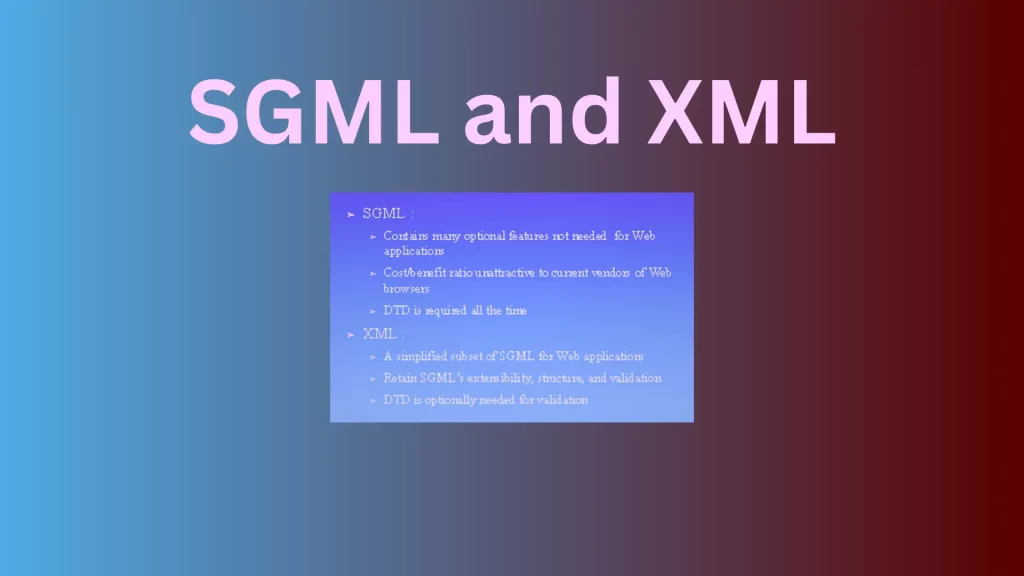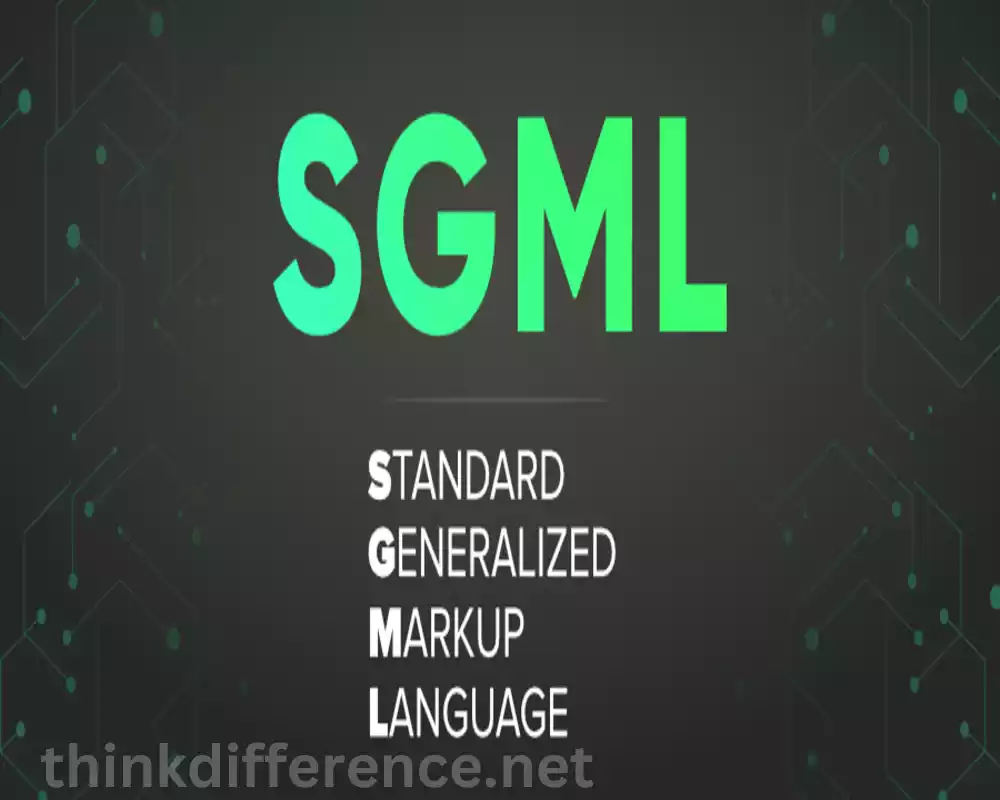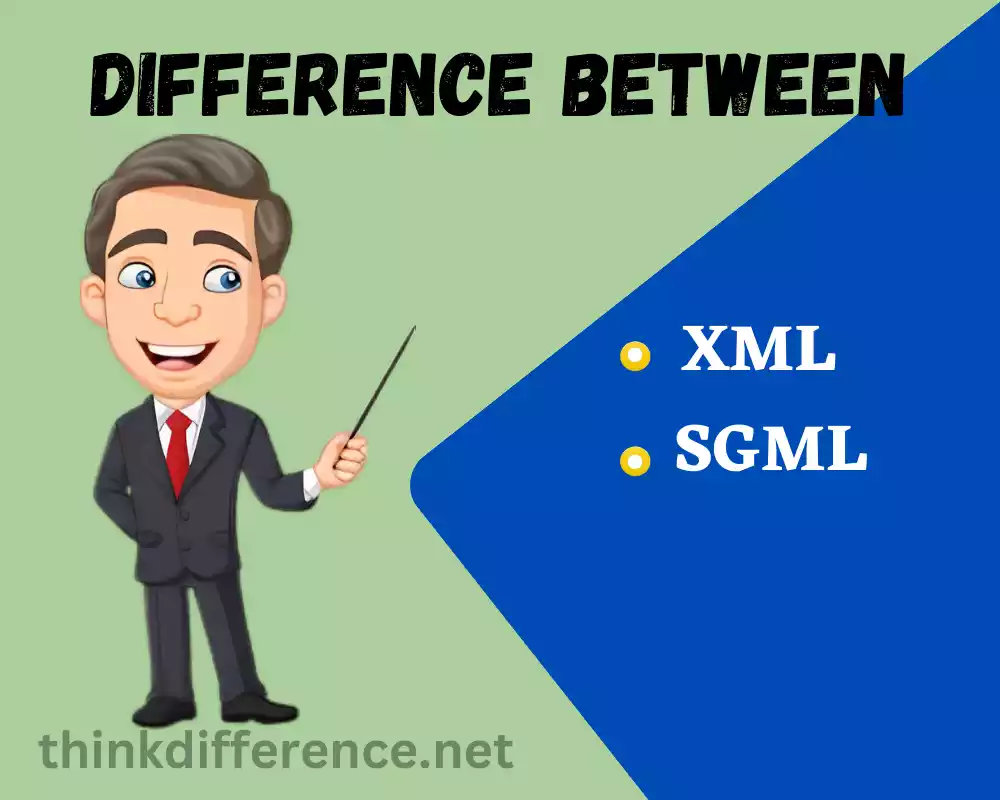XML and SGML have had significant influences in data representation and exchange fields, which makes this comparison interesting to explore their applications, differences, and characteristics between each markup language. We will take a close look here!
Definition of XML and SGML

XML:
XML is an extensible markup language which defines guidelines to encode documents that are both machine readable and human readable. It is a popular standard for structuring and representing data, primarily used for data exchange and storage. XML uses tags to define elements and attributes to provide additional information about those elements.
Users are given the power to define their own tags and create customized document structures – making the platform highly adaptable and flexible. XML is designed to be platform-independent and is widely adopted in various industries and applications, including web development, data interchange, configuration files, and document storage.
SGML:
SGML (Standard Generalized Markup Language) is a standard for defining markup languages and document structures. Document types provide the basis for document creation by outlining their structure and meaning within. SGML provides a set of rules for describing how elements and attributes should be used to mark up text and data. It allows the definition of custom document types by creating Document Type Definitions (DTDs), which define the rules and constraints for a particular markup language.
SGML is highly flexible and allows for complex document structures, making it suitable for large-scale publishing and documentation systems. While XML is derived from SGML and offers a simplified subset of its features, SGML is considered the more comprehensive and powerful markup language. Due to its complexity, SGML is less commonly used today compared to XML.
Importance of markup languages in data Representation
Markup languages play a pivotal role in data representation, providing a structured and standard way to format, format, annotate and present data in its final form. Here are some key reasons why markup languages are important in data representation:
- Structure and Organization: Markup languages allow for the hierarchical structuring of data, providing a clear and organized representation. By defining elements, attributes, and relationships, markup languages enable the creation of logical document structures, making it easier to navigate and process data.
- Interoperability and Portability: Markup languages facilitate the exchange and sharing of data across different platforms, applications, and systems. They provide a common syntax and structure that can be understood by various software tools and enable data interoperability, allowing seamless data communication and integration.
- Human-Readable and Machine-Readable: Markup languages strike a balance between being human-readable and machine-readable. They use tags and annotations to represent data elements, making it easier for humans to understand the content. At the same time, these tags and annotations provide a consistent structure that machines can parse and process programmatically.
- Data Presentation and Styling: Markup languages, combined with style sheets (such as CSS in HTML/XML), enable the separation of content and presentation. This separation allows for flexible styling and customization of how data is presented, enhancing the visual appeal and accessibility of information.
- Extensibility and Customizability: Markup languages often offer extensibility features, allowing users to define custom elements, attributes, and document types. This flexibility enables the adaptation of markup languages to specific domain requirements and the representation of specialized data structures.
- Metadata and Semantics: Markup languages support the inclusion of metadata and semantic annotations, providing additional context and meaning to the data. This metadata can describe the purpose, author, version, and other relevant information about the data, enhancing its interpretability and searchability.
- Long-Term Preservation: Markup languages contribute to data preservation and archiving. By using standard formats and well-defined structures, data represented in markup languages can be stored and accessed over extended periods without losing its meaning or becoming obsolete.
Markup languages are vital for data representation as they facilitate organization, interoperability, readability, customization, and preservation of data across diverse domains and technologies. They form the foundation for effective data management, exchange, and utilization in various industries and applications.
What is XML?
XML (Extensible Markup Language) is an extensive, universal markup language which represents structured data in various ways.

Here are a few facts about it that should give an idea of its versatility:
- Syntax: XML uses tags to define elements and attributes to provide additional information about those elements. Elements are enclosed within start and end tags, and they can be nested to create a hierarchical structure. Attributes provide additional metadata or properties for elements.
- Flexibility and Extensibility: XML allows users to define their own tags and create custom document structures. This extensibility enables XML to adapt to specific data requirements and allows for the representation of diverse data types and structures.
- Human-Readable and Machine-Readable: XML documents were specifically created so they would be both machine and human-readable. The use of descriptive tags and clear structure makes XML documents easily understandable by humans. At the same time, XML follows a strict syntax that allows machines to parse and process the data systematically.
- Platform-Independence: XML is platform-independent, meaning it can be used on different operating systems and computing environments. This makes it ideal for data interchange and communication between heterogeneous systems.
- Data Exchange and Interoperability: XML’s standardized format and widespread adoption make it suitable for data exchange between different applications and systems. XML facilitates interoperability by providing a common language for data representation, enabling seamless integration and communication.
- Document Type Definitions (DTDs) and XML Schemas: XML allows documents to be used both as Document Type Definitions (DTDs) and XML Schema Definitions (XSD) defining structures and validation rules for XML documents. These definitions enforce consistency and ensure that XML documents adhere to a predefined structure.
- Applications: XML is widely used in various industries and domains. It is commonly used in web development, data storage, configuration files, document management, and data exchange between systems. XML serves as the cornerstone for many technological innovations, such as SOAP (Simple Object Access Protocol) for web services and RSS (Really Simple Syndication), which facilitates content syndication.
- Transformation and Processing: XML can be transformed using technologies such as XSLT (Extensible Stylesheet Language Transformations) to convert XML data into different formats or render it for display. XML can also be processed using programming languages and APIs, allowing for data manipulation and integration with other systems.
XML provides a flexible, standardized, and extensible means of representing structured data. Its widespread adoption and support make it a fundamental technology for data exchange, integration, and storage in various domains.
What is SGML?
SGML (Standard Generalized Markup Language) is a robust and comprehensive markup language that served as the foundation for XML.

Here are some important aspects of SGML:
- Document Structure: SGML is an industry standard used to establish document structures. It allows the creation of custom document types using Document Type Definitions (DTDs). DTDs specify the elements, attributes, and their relationships, enabling the definition of complex document structures.
- Flexibility and Extensibility: SGML offers a high level of flexibility, allowing the definition of customized markup languages to suit specific requirements. It enables the creation of new elements, attributes, and document structures, providing extensive extensibility options.
- Complex Document Handling: SGML supports the representation of complex document structures, including nested elements, cross-references, footnotes, bibliographic references, and more. This capability makes it suitable for large-scale publishing systems, technical documentation, and content management systems.
- Content Markup and Separation: SGML emphasizes the separation of content and presentation. It focuses on marking up the structural and semantic aspects of the content, rather than dictating how the content should be presented visually. This separation allows for greater flexibility in rendering and styling the content for different output formats.
- Industry Standards and Compliance: SGML is an international standard (ISO 8879) that has been widely adopted in industries such as publishing, aerospace, defense, and government. Compliance with the SGML standard ensures interoperability and compatibility between different SGML-based systems.
- Document Type Definitions (DTDs): DTDs in SGML specify the rules, constraints, and allowed structure for documents. DTDs define the valid elements, their attributes, and the relationships between elements. They play a crucial role in ensuring document validity and integrity.
- Migration to XML: XML, derived from SGML, was introduced as a simplified and more manageable subset of SGML. XML retains many of the fundamental concepts and syntax of SGML while offering a streamlined and user-friendly approach. As a result, many organizations migrated from SGML to XML for its ease of use and wider support.
- Tools and Processors: Various software tools and processors exist for working with SGML, including editors, parsers, validators, and transformation engines. These tools facilitate the creation, manipulation, and processing of SGML documents.
Although XML has largely replaced SGML in many applications, SGML continues to be used in industries that require complex document structures and stringent control over document types. It remains an important predecessor and influential standard that contributed to the development of XML and other markup languages.
SGML and XML Applications
SGML and XML (Standard Generalized Markup Language and Extensible Markup Language respectively) have become ubiquitous across many industries and domains, providing solutions in areas spanning across finance, media, advertising and more.
Below are just a few popular uses of these two standards combined together:
- Publishing and Documentation: SGML and XML have been extensively used in publishing and documentation industries. They provide a structured and standardized format for managing and exchanging content, enabling efficient authoring, editing, and publishing workflows. XML-based publishing systems allow content reuse, dynamic delivery, and multi-channel publishing across print, web, mobile, and other platforms.
- Web Development: XML and XML-based technologies like XHTML and RSS have been fundamental in web development. XML provides a flexible and structured format for representing web content, enabling separation of content and presentation through the use of style sheets. XML-based web services, such as SOAP (Simple Object Access Protocol), facilitate interoperability and data exchange between different systems over the internet.
- Data Interchange: XML has become a widely used format for data interchange between different systems and applications. It allows for the exchange of structured data in a standardized and human-readable format. XML-based data formats, such as JSON (JavaScript Object Notation), are used extensively in web APIs and data integration.
- Data Storage and Databases: XML has been utilized for storing and representing data in databases. XML databases provide a native XML storage and retrieval mechanism, enabling efficient querying and manipulation of XML data. XML’s hierarchical structure and flexibility make it suitable for storing semi-structured and complex data.
- Configuration Files: XML is commonly used for defining configuration files for software applications and systems. These files contain settings, options, and parameters that define the behavior and customization of the application. XML-based configuration files allow for easy modification, versioning, and portability of application configurations.
- Electronic Data Interchange (EDI): SGML and XML have been used in the field of electronic data interchange, facilitating the exchange of business documents between trading partners. SGML-based EDI standards, such as EDIFACT (Electronic Data Interchange for Administration, Commerce, and Transport), have been widely adopted in industries like logistics and supply chain management.
- Scientific and Technical Documentation: SGML and XML have found significant applications in scientific and technical documentation, such as technical specifications, manuals, patents, and research papers. The structured nature of SGML and XML allows for efficient management, versioning, and dissemination of complex scientific and technical content.
- Government and Legal Documents: XML-based standards like LegalXML have been developed for the representation and exchange of legal documents. Governments worldwide have adopted XML-based formats for regulatory compliance, legislative documents, and government data dissemination.
These are just a few examples of the wide-ranging applications of SGML and XML. Their versatility, extensibility, and standardization have made them invaluable in industries and domains where structured data representation, content management, and data interchange are critical.
XML and SGML Transformation
XML and SGML transformation refers to the process of converting documents from one markup language to another or applying structural and presentational changes to the document’s content. Transformations are typically achieved using transformation languages and tools designed specifically for XML and SGML.
Here are some key aspects of XML and SGML transformation:
- XSLT (Extensible Stylesheet Language Transformations): XSLT is a powerful transformation language specifically designed for XML. It allows you to define rules and templates to extract, manipulate, and rearrange XML data. XSLT uses XPath to navigate the XML document and apply transformations based on matching patterns.
- XSL-FO (Extensible Stylesheet Language Formatting Objects): XSL-FO is an XML-based language used for describing the visual formatting of XML or SGML documents. XSL-FO provides a way to specify the layout, pagination, and styling of the transformed document. XSL-FO documents are typically transformed into various output formats like PDF, HTML, or print-ready documents.
- DSSSL (Document Style Semantics and Specification Language): DSSSL is a powerful transformation language primarily designed for SGML. It allows for complex structural transformations and styling of SGML documents. DSSSL provides fine-grained control over document presentation, layout, and content extraction.
- XQuery: XQuery is a query and transformation language for XML. It allows you to extract and transform XML data based on specified criteria and conditions. XQuery provides a flexible and powerful way to retrieve and manipulate XML content.
- XPath: XPath is a language used to navigate XML and SGML documents and select specific nodes based on their location and characteristics. XPath is commonly used in conjunction with XSLT and XQuery for specifying the context and target nodes for transformations.
- Transformation Engines and Tools: Various software tools and libraries are available for XML and SGML transformation. These tools provide transformation capabilities, allowing you to process and convert documents from one markup language to another. Some popular tools include XSLT processors like Xalan, Saxon, and Libxml, as well as DSSSL processors like Jade.
- Custom Transformation Scripts and Programs: In addition to specialized transformation languages and tools, you can also develop custom scripts or programs using programming languages like Python, Java, or Perl to perform XML and SGML transformations. These scripts leverage the libraries and APIs available for working with XML and SGML to implement specific transformation logic.
XML and SGML transformation plays a crucial role in content management, data integration, publishing workflows, and data interchange. It allows for the conversion, extraction, and restructuring of documents to meet specific requirements, styles, and output formats. The transformation process ensures that the resulting document maintains the desired structure, content, and presentation while conforming to the target markup language or format.
XML and SGML in Web Development
XML (Extensible Markup Language) and SGML (Standard Generalized Markup Language) have had significant effects on web development by offering structured data representation and interoperability between systems. Their implementation also makes for cost savings when building sites.
Here are four essential characteristics of these markup languages used for web development:
- Data Exchange and Integration: XML and SGML provide a standardized and platform-independent format for exchanging data between different web applications and systems. Web services, such as SOAP (Simple Object Access Protocol), utilize XML as a common data format for communication and integration between heterogeneous systems.
- Data Representation and Storage: XML is widely used for representing structured data on the web. It allows developers to define custom tags and elements to represent data in a hierarchical structure. XML documents can be stored, retrieved, and manipulated using databases, content management systems, or file-based storage.
- Syndication and Feeds: XML-based formats like RSS (Really Simple Syndication) and Atom have revolutionized content syndication and news aggregation on the web. These formats provide a standardized way for publishers to distribute and share content updates, allowing users to subscribe to feeds and receive updates from multiple sources.
- Web APIs: XML and SGML have been used in the design of web APIs, enabling data exchange and integration between web applications. XML-based formats like JSON (JavaScript Object Notation) have gained popularity as a lightweight alternative for data serialization and communication in RESTful APIs.
- Web Forms: XML and SGML concepts have influenced the design of web forms, providing a structured way to define form elements, data validation, and submission. Technologies like XHTML (Extensible Hypertext Markup Language) and XForms utilize XML-based syntax for defining interactive and accessible web forms.
- Web Content Management: XML and SGML have played a significant role in web content management systems (CMS). CMS platforms often use XML-based formats for storing and managing structured content, allowing for flexible content modeling, content reuse, and multi-channel publishing.
- Document Transformation and Styling: XSLT (Extensible Stylesheet Language Transformations) enables the transformation of XML and SGML documents into different output formats, such as HTML, PDF, or plain text. XSLT provides a powerful mechanism to extract and rearrange data, apply styles and formatting, and generate dynamic web content.
- Semantic Web: XML and SGML principles have influenced the development of the Semantic Web, a vision of linked and machine-understandable data on the web. XML-based languages like RDF (Resource Description Framework) and OWL (Web Ontology Language) provide a foundation for representing and linking structured data in a semantic manner.
XML and SGML have shaped various aspects of web development, including data representation, data exchange, content management, and web service integration. They have provided a foundation for interoperability, data standardization, and structured data handling on the web. While XML has gained wider adoption due to its simplicity and flexibility, SGML continues to influence XML and serve as a foundation for more complex markup languages and systems.
Comparison table of XML and SGML
Here is a comparison table highlighting some key differences between XML and SGML:
| Feature | XML | SGML |
|---|---|---|
| Purpose | Designed for web data representation | Designed for general-purpose data representation |
| Syntax | Fixed set of predefined tags and attributes | Allows customization with user-defined tags and attributes |
| Document Type Definition | Optional, uses XML Schema or DTD | Mandatory, uses DTD |
| Tag Naming Conventions | Case-sensitive | Case-insensitive |
| Tag Nesting | Strictly hierarchical | Hierarchical with optional overlapping and mixed content |
| Extensibility | Limited extensibility through namespaces | High extensibility with user-defined markup constructs |
| Validation | Can be validated against a schema or DTD | Must be validated against a DTD |
| Self-Describing | Yes, XML documents contain their structure | No, requires an external DTD for structure information |
| Popularity | Widespread adoption in web development | Less prevalent, mainly used in legacy systems |
| Industry Standards | Many industry-specific XML-based standards | SGML-based standards exist in specialized domains |
Future of XML and SGML
What the future holds for XML (Extensible Markup Language) and SGML (Standard Generalized Markup Language) depends on many variables, including technology innovations, standard advancement, data storage needs and representation needs in modern data environments.
Here are a few trends and suggestions about where these two markup languages may lead:
- Shift towards JSON and Lightweight Formats: JSON (JavaScript Object Notation) has gained significant popularity as a lightweight and efficient data interchange format, especially for web APIs and mobile applications. While XML and SGML will continue to be used in certain domains, there may be a gradual shift towards JSON and other lightweight formats for data representation and exchange.
- XML Schema and Validation Improvements: XML Schema, a more advanced schema language for XML, offers enhanced validation capabilities compared to DTDs (Document Type Definitions). Further developments in XML Schema and validation technologies are expected to improve the validation and constraint-checking capabilities for XML documents.
- Continued Use in Legacy Systems: XML and SGML have a strong presence in legacy systems, particularly in industries where structured data representation and content management have been established. These systems may continue to rely on XML and SGML for the foreseeable future, even as newer technologies emerge.
- Industry-Specific Standards and Domains: XML and SGML are likely to persist in industry-specific domains where standardized data representation and interchange are essential. Industries such as publishing, documentation, legal, and government have established XML-based standards and practices that may continue to rely on XML and SGML for data management and exchange.
- Evolving Semantic Web and Linked Data: The vision of the Semantic Web, where data is linked, interconnected, and machine-understandable, continues to evolve. XML and SGML-based technologies, such as RDF (Resource Description Framework) and OWL (Web Ontology Language), contribute to the development of semantic data representation and metadata standards. The integration of XML and SGML with semantic technologies may further shape their future applications.
- Integration with New Technologies: XML and SGML will likely integrate with emerging technologies and standards to address evolving data representation needs. This includes integration with NoSQL databases, cloud-based data management, microservices architectures, and big data processing frameworks. XML and SGML may serve as structured data sources or be used in data transformation and integration workflows.
- Ongoing Maintenance and Support: While new technologies may overshadow XML and SGML in terms of popularity, the existing XML and SGML infrastructure will still require maintenance and support. Organizations and systems relying on XML and SGML will continue to need expertise in these technologies to manage and maintain their data.
Technological trends change constantly, XML and SGML’s future success depends on ever-evolving needs in different sectors and advancing data representation technologies as well as overall exchange and management of information. Nonetheless, the principles and concepts of XML and SGML, such as structured markup, data separation, and standardization, continue to inform and influence modern data representation practices.
Conclusion
Both XML and SGML have significantly contributed to the field of markup languages, shaping the way data is structured and shared. XML’s simplicity and compatibility have made it the go-to choice for web developers, while SGML’s precision and control cater to industries with complex documentation needs. As technology progresses, these markup languages will continue to evolve, ensuring that information is organized, accessible, and future-proof.



